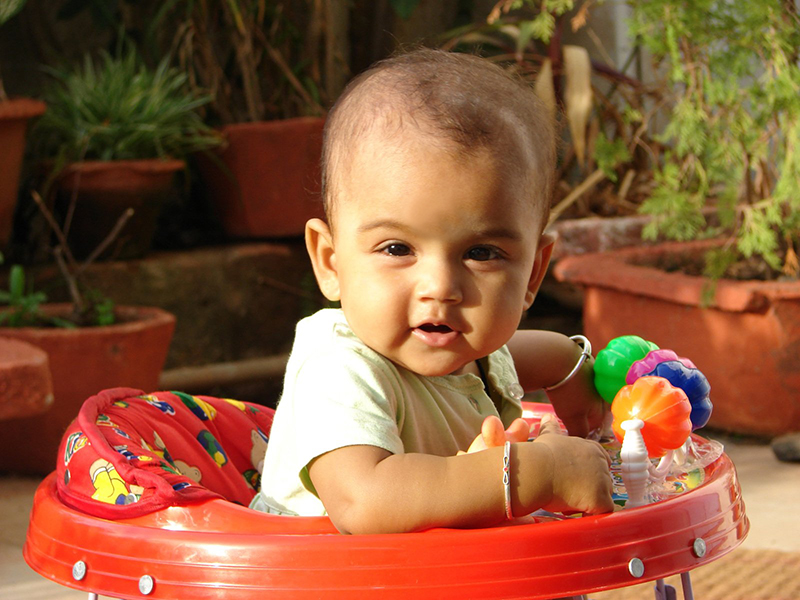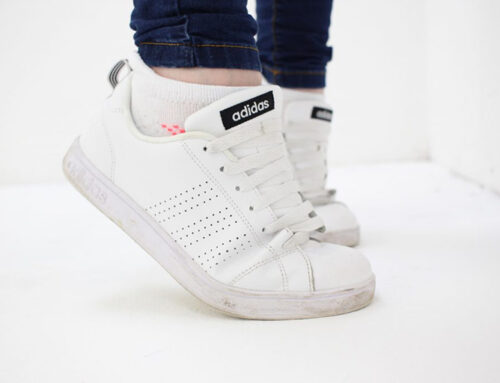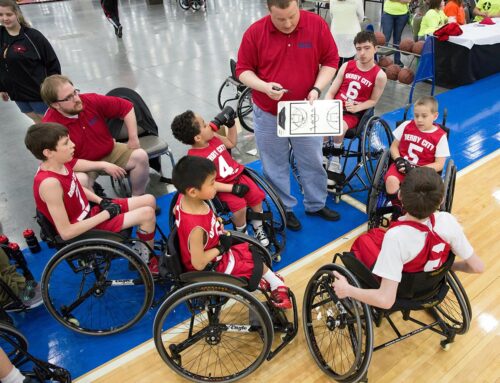Top 5 Reasons To Ditch The Baby Walker
- SAFETY
Did you know that baby walkers have been banned in Canada since 2004? The fine for selling one is up to $100,000 or 6 months in jail. The American Academy of Pediatrics has been calling on a ban for years. The bottom line is, too many children hurt themselves by falling down stairs, flipping over, crashing into dangerous things, or reaching for dangerous objects they wouldn’t otherwise be tall enough to reach. Kids can move fast in walkers, sometimes faster than a parent can catch them. Remember, they’re on wheels and you are not.

Let’s face it. It’s impossible to keep an eye on kids 100% of the time and accidents happen in the blink of an eye. Of course, there are safety measures you can take to minimize these risks, but ultimately, the stats speak for themselves. Even with new devices that have special brakes, are too wide for doorways, and the appearance of “Activity-centers” sans wheels (don’t get me started on the demerits of those!), a whopping 1,402 children still injured themselves in 2014 due to the use of these devices. [1]
2. CONTAINER BABY SYNDROME
These days, when you look at baby registries, they all include what us therapists like to call containers. They are places you can put Baby in that they can’t wriggle out of. Some examples include: exersaucers, Bumbo chairs, car seats, high chairs, swing seats, and of course, baby walkers. Some of these are necessary (car seat, high chair). Most of the rest are not. The biggest misconception is that your baby is getting “exercise” in a baby walker. Currently, baby walkers are marketed for children aged 5 to 15 months. You know what the best exercise for a 5-15 month old is? Tummy time. Click here to get some tummy time tips!
Of course, kids want to be upright so they can see the world from a different vantage point. Of course, you want to be able to do some dishes or go to the bathroom while they are contained and unable to climb, fall, or otherwise move in an unsafe way (See point #1 above for refutal). I would instead recommend buying a Pack ‘n’ Play. Or if you want to go all out and spend $150, get a set of interlocking foam mats and a baby fence. This way your child is free to explore their environment safely and age appropriately.

3. IT DOES NOT TEACH YOUR CHILD HOW TO WALK
As a physical therapist, we study movement. It is our area of expertise. Let’s break down the movement your child makes when they are in a baby walker. First, they lean forward with their hips. Since their body is supported by a harness, they do not fall on their face. They then go up on their toes in order to continue to advance the walker. Finally, they take steps forward (or sideways, or backwards) while in a harness that impedes their ability to learn postural control and natural reactions your core develops as a consequence to losing your balance.
Now stand up and try to, VERY slowly, take a step. You will notice that the first thing you do is NOT lean forward. The first part of walking is actually a weight shift sideways so that your weight is off the foot you are about to step with. So children who spend a lot of time “learning to walk” in baby walkers have to UN-learn the motor pattern of leaning forward in order to begin to walk on their own. It can be a tough habit to break.
Furthermore, some researchers [2] who have studied in depth the way children walk (gait pattern) while in a baby walker have concluded that because of the amount of knee stiffness, length of each stride, and trunk lean, their gait pattern looks suspiciously like the gait of a child with cerebral palsy. (!!!)
4. TOE WALKING
As described in #3 above, part of the mechanics of walking in a baby walker is to push off the balls of your feet. In a 2018 study published in the Journal of Pediatric Traumatology, Orthopedics, and Reconstructive Surgery, authors identified the use of baby walkers as a factor contributing to the toe-walking pattern. [3]
Toe walking can lead to calf tightness, and over time, deformation of the bones of the foot, gluteal and core weakness. In mild cases, your child could benefit from stretching and gait re-training to treat the issue. In extreme cases, surgery is required to lengthen the Achilles tendon.
Of course, not every child develops a toe walking pattern in a baby walker. But how do you know your baby won’t?
5. NOT ONLY DELAYED MOTOR, BUT ALSO COGNITIVE DEVELOPMENT
Some studies [4,5] have found that children who are experienced in baby walker use sit up, crawl, and walk later than their peers who do not use baby walkers. Interestingly, they also score lower on the Bayley Scale (a standardized test for mental and motor development). This makes sense if you know that, early in life, movement stimulates brain development. Things like Cause & Effect, Object Permanence, and Depth Perception are all developed before one year of age through physical exploration of the world.
Another aspect that you may not have considered is that baby walkers block your child’s view of their feet. Visual feedback can have an important impact on a developing motor system. The development of spatial body awareness or proprioception is a key factor in preventing a child’s future falls.
The list above is not meant to pass judgment on your parenting skills, or the skills of your parents before you. When a product is as ubiquitous as the baby walker, it is easy to fall into the trap of believing your baby needs one, too. But the fact is, they don’t need it. And in some cases, it can actually be harmful. If you already own one, don’t use it for more than 15 minutes per day. And if you don’t have one yet, leave it off the baby registry! Instead, get a push toy that allows your child to use their core, see their feet, and learn to walk.
[1] http://pediatrics.aappublications.org/content/142/4/e20174332
[2] Engelbert, R.H.H., R. van Empelen, N.D. Scheurer, P.J.M. Helders and O. van Nieuwenhuizen, 1999. Influence of infant-walkers on motor development: Mimicking spastic diplegia? Eur. J. Paediatr. Neurol., 3: 273-275.
[3] Alla V. Krivova and Alexander N. Sharov, Baby walkers and the phenomenon of toe-walking, Pediatric Traumatology, Orthopaedics and Reconstructive Surgery, 10.17816/PTORS6123-32, 6, 1, (23-32), (2018).
[4] J Dev Behav Pediatr. 1999 Oct; 20(5): 355-61.
[5] Marian Magdy Shafeek and Emam Hassan El-Negmy, 2016. Effect of Usage of Baby Walker on Acquisition and Pattern of Independent Gait in Normal Children. Trends in Medical Research, 11: 76-81.

Eyas Landing is a therapy clinic with a mission to provide evidence-based and family-centered therapy services for children, adolescents, and their families. The primary goal is to deliver relationship-based interventions within the most natural environments and to empower families to reach their full potential. To achieve this goal, our highly educated, compassionate staff dedicates time and expertise to create experiences that maximize therapeutic outcomes. The strength, determination, and perseverance of our clients are evident as they succeed in therapy, and ultimately in their daily lives.
Eyas Landing offers a wide range of comprehensive services including Speech Therapy, Occupational Therapy, Physical Therapy, ABA Therapy, Social Work, Family Therapy, and Neuropsych testing. Services are provided throughout the Chicagoland area via Telehealth, In-Home, and in our state of the art clinic.
Want to learn more or you have a specific question? Feel free to connect with us here!



